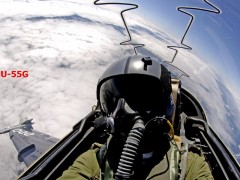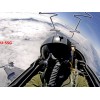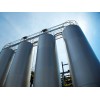CONTEXT
Generally, scene resolution in contemporary flight simulators is not high enough for military jet pilot training. To overcome this problem, high resolution small-field-of-view projectors have been used to represent certain critical details. However, this approach limits the number of details that can be correctly represented and causes contrast problems with the background image. Our objective: to design a system that can simulate entire scenes with a resolution of approximately 20 megapixels.
MEMS SLM (Spatial Light Modulator) prototypeCanadian Department of DefenceMicromirrorMEMS SLM (Spatial Light Modulator) prototypeCanadian Department of Defence
SOLUTION
The solution developed by our specialists is based on an innovative micromirror whose curvature can be modified by electrostatic attraction. When integrated in an innovating optical system, the micromirror produces a pixel of light whose intensity, which depends on micromirror curvature, can be modulated at over 300 kHz. This quick response time produces high resolution monochromatic images when a linear array of such micromirrors is combined with a scanner. We therefore developed a projector based on this new type of micromirror. The current prototype can already project VGA image sequences at a 60 Hz frame rate.
FURTHERMORE
This system uses a 480 micromirror linear array. It is compatible with the DVI standard.
Ultra-high resolution
Tests have shown that the technology could potentially yield 5,000 column images displayed at a frame rate of 60 Hz. The number of lines in the image is determined by the number of micromirrors in the linear array. To date, linear arrays with up to 4,000 micromirrors have been fabricated. Superimposing three monochromatic images of different colors (e.g., red, green, and blue) produces a high resolution color image. In this type of projector, an optical relay combined with masks produces pixels whose intensity is determined by micromirror curvature. The pixel column produced is projected onto a screen. A galvanometer in the projection system scans the screen by displaying all the columns of an image in sequence. The number of columns is currently limited by the control electronics used. The contrast obtained depends on operating conditions and can reach 300 with the current configuration.













